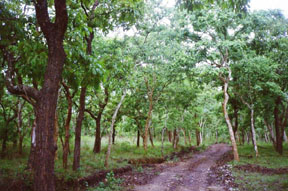Inside the woodlands of Wodeyars
Part I
-Saraswati Kavula
Is there a conflict between eco-tourism and conservation? This was the big
question that bothered me on my recent trip through the forests of the erstwhile
kingdom of the Wodeyar Family, more popularly called the Mysore Maharajahs.
In a bid to escape the heat of the Hyderabadi summer, I planned a trip to
Coorg, in the Nilgiris. But somehow the idea of a wildlife safari also enticed,
the place being pretty close to Mysore City. So my first stop after Mysore was
the Bandipur Safari Lodge, about 2 kms outside the Bandipur Wild Life Sanctuary.
We hopped onto a Swaraj Mazda that was heading towards Ooty, to get off at
Bandipur enroute. “it will take you just two hours and by nine thirty you will
reach there”, the man who ran the service told us in Mysore, “Be there by 7 am”.
Our fears of reaching the place earlier than the check in time were unfounded.
The Mazda did not leave Mysore until 9am and therefore, we were sitting like
trussed chicken inside the van from 7.30 until we reached Bandipur after a
rickety ride that took nearly two hours of waiting and another two and half
hours of drive to cover the 72 kilometers distance from Mysore to Bandipur. 
We seemed like aliens getting off this “Oh, so poor looking vehicle” in the posh environs of the Lodge. “Posh”, I would say, because actually I expected something like tents or bamboo
huts for accommodation inside a deep, deep jungle. The hills around the Lodge were absolutely bare except for a shrub here and there. And the lodge itself was made of steel and concrete, albeit in a
cottage style – there were twelve in all, well furnished complete with granite
topped wash rooms,12 cottages complete with granite topped wash areas, a
generator to back-up for electricity, electric geysers (of course, most of the
time, there was a power shut down, so the smoke spewing, noisy generator had to
be kept active).
When I asked the manager about the generator, he said, “We had a noiseless generator, but that is under repair, so we are using this as a standby.” I asked him, could they install a
solar power for the back up at least? He asked me to suggest this to the management.
The rooms were cool and thankfully there was no air-conditioning or television. 
The most beautiful part was the lifelike painting of the white tiger on the back
wall.
A small restaurant for highway travelers, in addition to a Gazebo serving up a choice of Indian and continental meals for the in house customers, completed the list. It was very much unlike my past experiences in a forest area. With the YHA treks, all
you had was a sleeping bag inside a tent and a backpack carrying your own pots and pans, the forest for a toilet and a very basic meal of chappatis, some vegetables and lentils.
On the day we arrived, the rain beating down the hillside dashed our hopes.
But Gangaswamy who manages the place was positive, “Rain or no rain, we shall take you on the safari”. Sans any expectations, we drove into the sanctuary.
Asides to the two jeeps from the Safari Lodge, there were many more jeeps from other “Wild Life Resorts” at the entrance of the sanctuary.
A little while after entering the sanctuary, each vehicle went on a different route.
We found some wild boars and chital to begin with, Sambar and peacocks along with many birds.
On our way we met the other group as well, who had seen a group of Bison. But since everyone was looking for the signs of the big cat, Pradeep our driver took
us towards a small watering hole in the middle of a bamboo forest.
After a bit of waiting, we decided to leave. “People, make too much “galata” (noise) here,
one has to be quite in order to see the animals,” Pradeep rued in Kannada. “It
perhaps would have been a better idea to
walk than to come like this in jeeps, too much disturbance to the animals, no?” I replied in my broken Tamil/Kannada mix. Pradeep nodded in agreement. 
At another place, Pradeep stopped and told us to keep silent, “Alarm call, he
told us, showing us the perked up ears of the spotted deer that was letting out
a sound indicating the presence of a carnivore. “It could be the tiger or
leopard”,
Pradeep spoke in hush-hush tones. After what seemed like eternity, we
went back on our way to the Lodge, but not before we saw some peacocks and a
lovely sunset.
Photographs-
1.Inside the Bandipur forest
2.Diesel spewing generator
3. Tiger Room
(Text and photographs Saraswati Kavula)
-To be continued